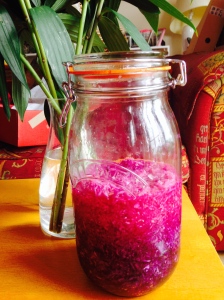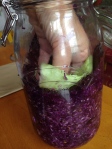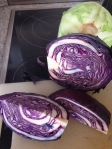 Sauerkraut is a traditional fermented food which produces probiotics, cheaply and naturally.
Sauerkraut is a traditional fermented food which produces probiotics, cheaply and naturally.
Probiotics are good bacteria which help good digestion, as Sacramento Natural Food Co-op explains.
“Fermented” food can sound a turn-off to our modern ears. But, for aeons, every traditional society has used lacto-fermented food – kimchi from Korea and cortido from Latin America, says Nourishing Days – for healthiness.
Sauerkraut hails (as do my ancestors) from Eastern Europe, Germany/Poland etc
I have been thinking about making sauerkraut for ages.
I bought a Kilner jar in preparation. I procrastinated. I had never made it before so feared failure. Making any food is a leap of faith. Will its mysterious alchemy work?
Then, by chance, I got a comment from Annie Levy, who holds UK-based lacto-fermentation workshops. Can you imagine? The maven of probiotics turns up on this ‘ere blog. Of course, I have to make sauerkraut. Now.
So I read Annie Levy’s great piece on making sauerkraut.
I also consulted this sauerkraut one from the Kitchn and a few others. Exciting to be in the zeitgist – there is no shortage of posts on lacto-fermentation.
Lacto, I query? It means the type of bacteria which creates lactic acid. Lactic acid protects fermented food from being invaded by bad bacteria, says Natural News.
Basically, to make sauerkraut, you add salt to cut-up raw vegetables. Salt naturally draws out the water from the veg. Then the veg soaks in its own salty water for days (and then keeps in a fridge for weeks). The soaking-in-the veg’s-own-water creates the fermentation process which in turn produces sauerkraut with loads of friendly bacteria.
Sauerkraut
1 raw cabbage (and/or raw carrots/garlic etc)
1 tablespoon salt
Spices of choice: I used 1 dried chilli, fenugreek, cumin seeds and black peppercorns
Method: Slice cabbage thinly (my food processor did the job otherwise use a sharp knife). Mix the salt and veg in a bowl, rubbing the salt in with your fingers. Leave the salted veg in a covered bowl. I am amazed how quickly I was squeezing water out of salted cabbage. Mix again. Keep cabbage submerged in its water with a heavy plate.
 Here is me submerging the veg in the Kilner jar using a cabbage leave to press it down. I got anxious about this bit. However, it is OK to add a few dessertspoons of water to make the sure the veg is covered. After 12-24 hours, transfer the salty cabbage from covered bowl to a Kilner jar and keep in the fridge.
Here is me submerging the veg in the Kilner jar using a cabbage leave to press it down. I got anxious about this bit. However, it is OK to add a few dessertspoons of water to make the sure the veg is covered. After 12-24 hours, transfer the salty cabbage from covered bowl to a Kilner jar and keep in the fridge.
I used two organic cabbages (and two tablespoons of salt). I thought two cabbages would not fit in the Kilner jar …but they did not even fill it!
The quantity of salt to use is up to you, but 3 tablespoons per 5 pounds of vegetables is a good ratio to follow, says website, Paleo Leap.
The result: Having lived with my jar of sauerkraut for the month of July, with regular servings with a variety of dishes, I can report: it is delicious. A blend of salty and sweet, and easy to eat.
And, it works. For instance, last night, my digestion felt weak. I could not be bothered to eat. So, I had a small bowl of sauerkraut and within an hour, my appetite had returned, heartily. The magic of friendly bacteria!



Good one, I’ve never thought of making it and I love that sort of stuff. I did some preserved lemons when they were really cheap last year. They were great, much better than I’d thought they would be. You’ve inspired me to have a go at sauerkraut now.
LikeLike
Delighted to hear…and big YUM re: preserved lemons. That is another super good idea.
LikeLike
Fascinating!
LikeLike
Looks delicious and delighted you inspired Paul. I never knew that what sauerkraut was.
LikeLike
Hooray!!!!!!!!!!!!!!
LikeLike
One thought, may I be so bold? Try to match the size of your ferment to the size of jar. The extra headroom,especially in the beginning, is an invitation to the less salubrious micro-organisms…. Am so happy you’re doing this!
LikeLike
Annie, Thank you so much for a) synchronicity b) inspiration and c)
very helpful comment about getting enough cabbage to fill the jar
(or use a smaller jar!). Very helpful! Elisabeth
LikeLike
This sounds great! I like its simplicity. This is a good idea of using left-over cabbage. An idea inspired.
Nina
LikeLike
This is simply captivating. I am encouraged to make Sauerkraut at home on weekend. What’s good to hear about making one is its deliciously sweet and salty taste! Thank you for this!
LikeLike
Thanks, Earl. Yes, I am captivated by sauerkraut too! The added joy is that the batch I made in July (and kept in fridge) tastes as fresh as ever. Delicious taste and a great accompaniment with every savoury dish I have tried it with.
LikeLike
I actually let mine ferment in the jar covered only with muslin cloth for 10 days to two weeks. As long as the liquid is covering all the cabbage, it’s fine. A weight on it helps. I do taste it from time to time and when I like the level of sourness, I seal the jar and keep it in the fridge. The rough recipe can be found here: http://www.wildfermentation.com/category/sauerkrautrecipes/
I have “Wild Fermentation” by Sandor Ellix Katz and I find it a pleasure to read and very useful too… I recommend it.
LikeLike
Fantastic, Jenny! Good to know you can keep it out of the fridge for two weeks or under. Great to get extra tips and book recommendation. Yes, now I am more in the swing of it, I see that you cannot go too far wrong with sauerkraut.
LikeLike
The key key is to keep the kraut covered by the liquid. The desired fermentation here is anaerobic -meaning no air gets to the kraut. The opposite and undesirable reaction is aerobic -meaning oxygen gets to the cabbage. Aerobic and anaerobic micro organisms are totally different. An aerobic fermentation will spoil the pot and create a slimy, smelly mess.
LikeLike
Michael, that is terrific. Thanks for adding to my knowledge about sauerkraut. Yes, keep the veg covered by the liquid.
I am happy to say that I am now on my second lot of sauerkraut (this time made with beetroot and ginger – it is so versatile!), and the raw veg has stayed as crispy as ever.
I keep the veg submerged by the liquid, and the jars in the fridge, and decant to smaller jars as I go.
LikeLike
Pingback: Starting the Sauerkraut | Fisher Lane